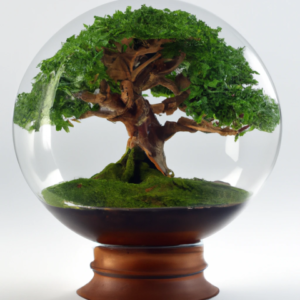Last month, I watched a friend struggle with her first terrarium as the plants slowly wilted despite her best efforts. She chose a closed glass container but filled it with succulents that needed dry conditions.
This common mistake showed me how important it is to match your terrarium type with the right plants and care routine.
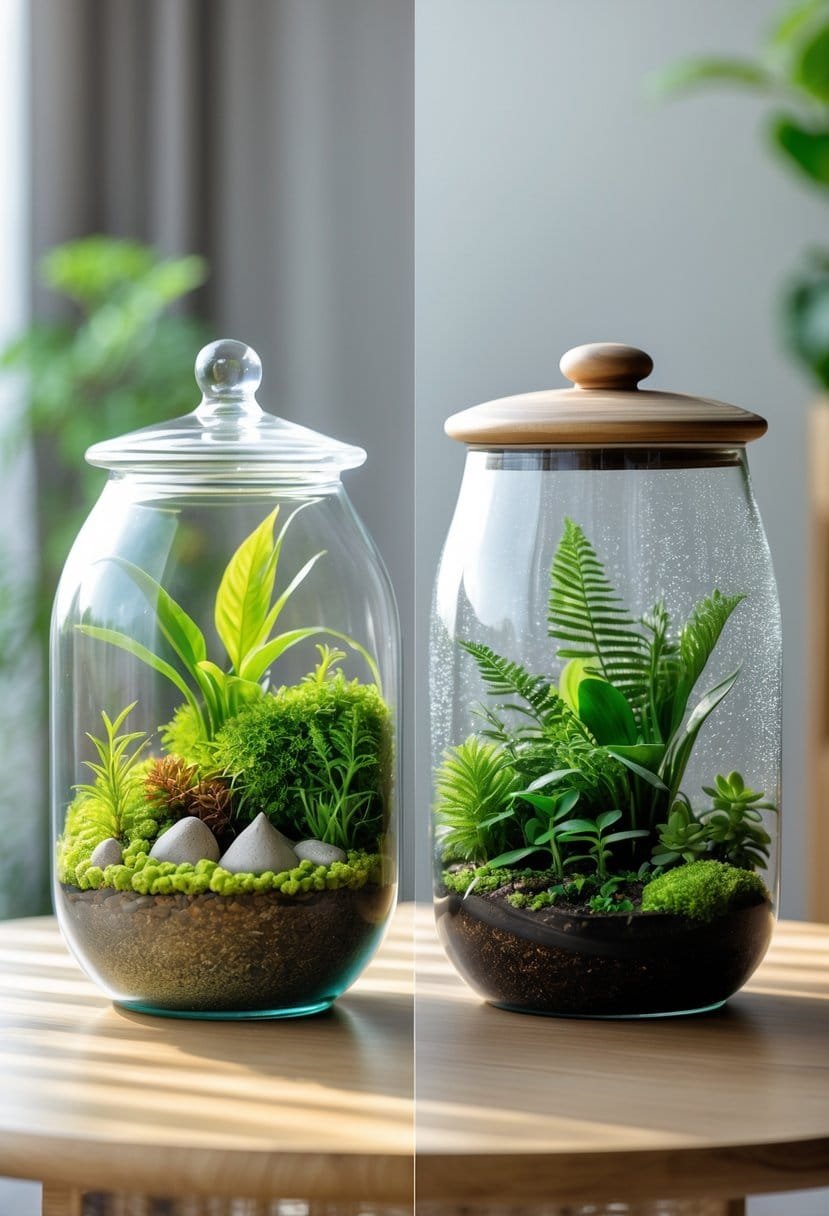
You should choose between open and closed terrariums based on the plants you want to grow and your preferred maintenance level. Open terrariums allow air circulation and work well for dry plants![]() .
.
Closed terrariums create humid environments that tropical plants love![]() . Each type offers different growing conditions that affect watering and plant health.
. Each type offers different growing conditions that affect watering and plant health.
I’ll walk you through the key differences between these two terrarium styles so you can pick the right one for your space. You’ll learn which plants thrive in each environment and what maintenance each type requires to keep your miniature garden healthy.
Key Takeaways
- Open terrariums need regular watering and work best for cacti, succulents, and plants that prefer drier conditions
- Closed terrariums create their own water cycle and are perfect for tropical plants that love high humidity
- Your choice should match your preferred maintenance level and the specific plants you want to grow
What Are Open and Closed Terrariums?
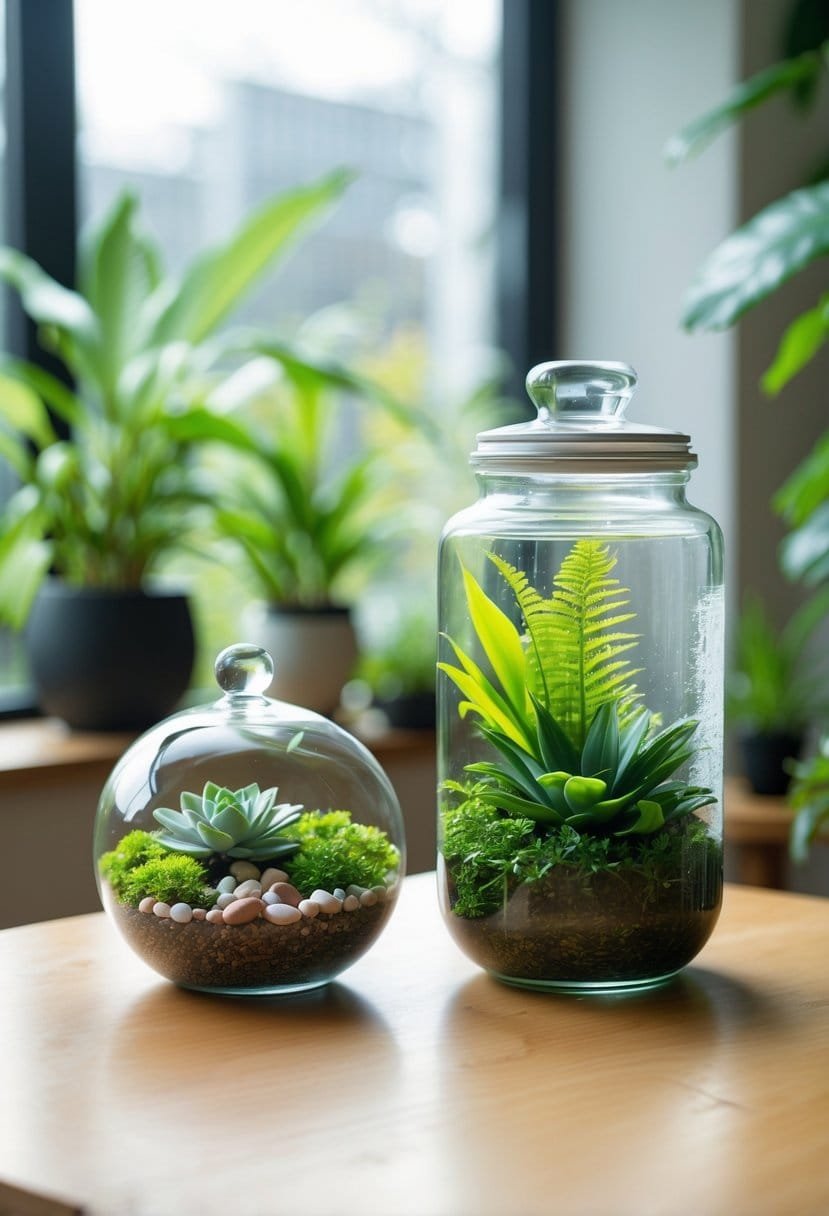
Terrariums are miniature gardens inside glass containers. Open terrariums have ventilation openings, while closed terrariums are completely sealed systems.
Defining Open Terrariums
Open terrariums are glass containers with at least one opening for air circulation. These containers usually have wide mouths or no lids.
Common examples include glass fishbowls, jars without lids, or wide-mouth vases. The opening lets fresh air flow in and out.
This ventilation prevents excess moisture buildup. It also helps control temperature inside the terrarium.
Key characteristics of open terrariums:
- At least one opening for air flow
- Require regular watering
- Better suited for dry-climate plants
- Easier to maintain and access
The size of the opening affects how much moisture stays inside. Smaller openings keep more humidity than wide ones.
Defining Closed Terrariums
Closed terrariums are sealed glass containers with no openings to the outside air. This design dates back to Victorian times.
A closed terrarium creates its own water cycle. Water moves from soil to plants, then back to the container walls through condensation.
These systems can run for long periods without extra water. The sealed environment maintains constant humidity.
Key features of closed terrariums:
- Completely sealed from outside air
- Self-sustaining water cycle
- High humidity environment
- Minimal maintenance once established
Closed terrariums work best with tropical plants that love humidity. The sealed environment copies rainforest conditions.
Key Differences in Structure
The main structural difference is air access. Open terrariums allow air exchange, while closed ones prevent it.
| Feature | Open Terrarium | Closed Terrarium |
|---|---|---|
| Air circulation | Yes | No |
| Humidity level | Variable | Constant high |
| Watering needs | Regular | Rarely needed |
| Temperature control | Better | Limited |
Glass containers for open terrariums often have wider openings. This makes planting and maintenance much easier.
Closed terrarium containers need tight-fitting lids or cork stoppers. The seal must be airtight to keep the environment stable.
Open terrariums give you more control over growing conditions. You can adjust watering and improve air flow as needed.
The structural design affects plant selection. Open terrariums work well for cacti and succulents![]() , while closed ones suit tropical plants better.
, while closed ones suit tropical plants better.
Comparing Environmental Conditions
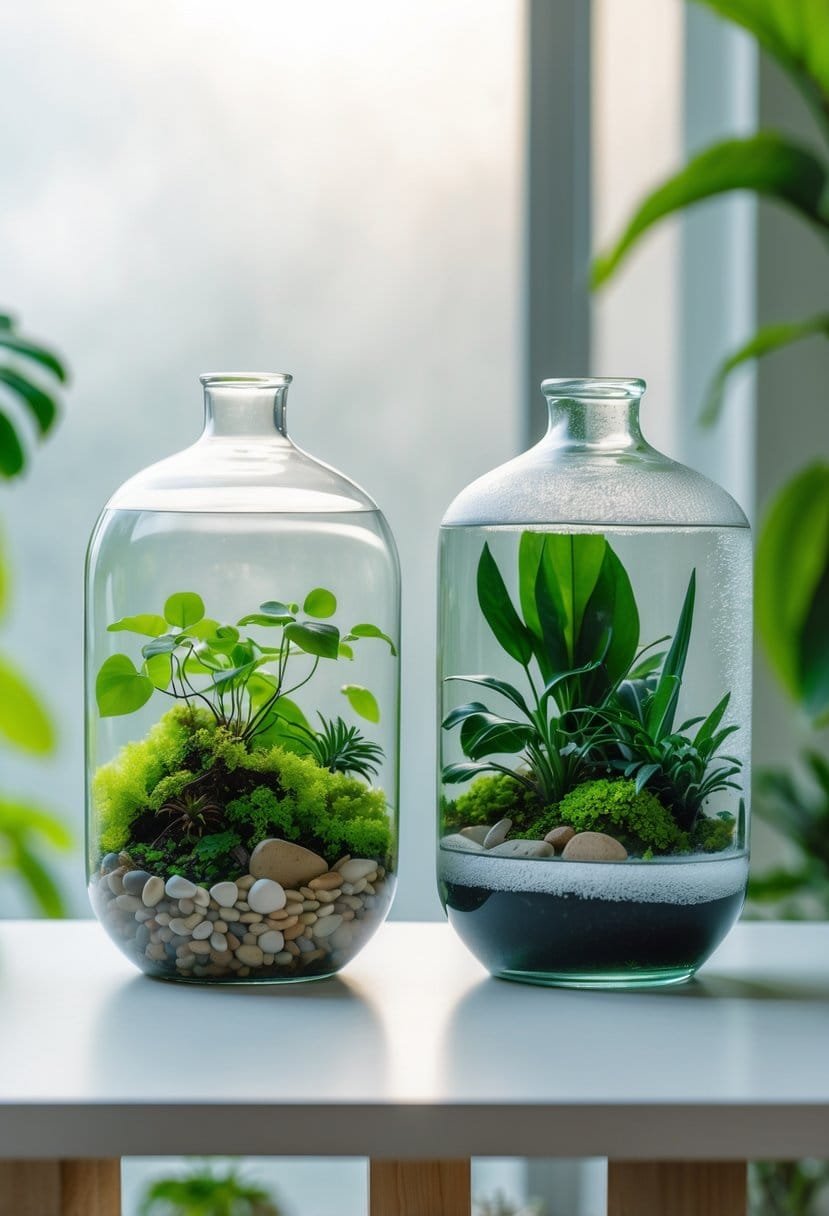
Open and closed terrariums differ in how they control air flow and moisture levels. Open systems let fresh air move freely, while closed systems trap humidity.
Air Circulation and Ventilation
Open terrariums provide constant air circulation between the container and surroundings![]() . Fresh air flows in and out easily.
. Fresh air flows in and out easily.
This airflow prevents stagnant conditions and removes extra moisture that could cause mold or fungal problems.
Closed terrariums have limited air exchange![]() . Some have lids that you can open occasionally, while others are completely sealed.
. Some have lids that you can open occasionally, while others are completely sealed.
Trapped air creates a stable microclimate inside. However, poor ventilation can cause condensation buildup on glass walls, blocking light and encouraging bacteria.
Humidity Control
Open terrariums maintain lower humidity levels because moisture evaporates into the room. I water these systems more often since they dry out faster.
Humidity stays close to your home’s natural levels. Open terrariums are perfect for desert plants and succulents that like drier conditions.
Closed terrariums create humid environments ideal for tropical plants![]() . The sealed container traps water vapor from soil and plant transpiration.
. The sealed container traps water vapor from soil and plant transpiration.
Humidity levels can reach 80-90% inside closed systems. This supports plants that need constant moisture around their roots and leaves.
Light and Temperature Considerations
Both terrarium types need bright, indirect light for healthy plant growth. Direct sunlight can overheat either system and harm plants.
Open terrariums handle temperature changes better because air circulation helps regulate heat. They cool down faster when room temperatures drop.
Closed terrariums act like mini greenhouses that trap heat and moisture. Temperature changes happen slowly but can build up to dangerous levels in sunny spots.
I recommend using LED grow lights for both types when natural light is low. These lights produce less heat and won’t create hot spots.
Plant Suitability for Each Terrarium Type
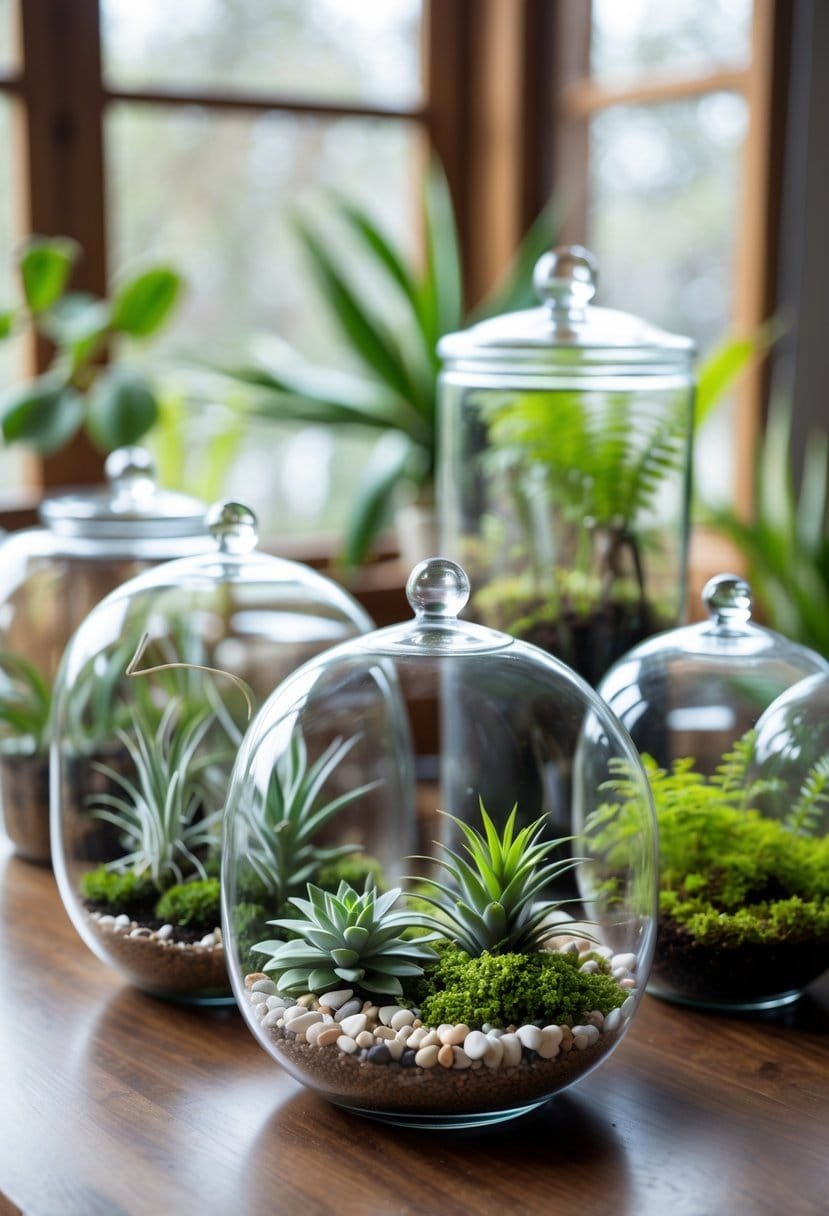
The right plant selection determines whether your terrarium thrives or struggles. Moisture-loving plants for closed terrariums![]() prefer high humidity, while drought-tolerant species do well in open systems.
prefer high humidity, while drought-tolerant species do well in open systems.
Moisture-Loving Plants for Closed Terrariums
I recommend ferns as the top choice for closed terrariums because they thrive in humid conditions. Maidenhair ferns, button ferns, and bird’s nest ferns create lush green displays.
Mosses work perfectly as ground cover in closed systems. Sheet moss and cushion moss form carpets that help maintain moisture.
Fittonia plants, also called nerve plants, add colorful veined leaves to closed terrariums. These plants love the consistent humidity.
Peperomia varieties like watermelon peperomia and baby rubber plants stay compact and enjoy the moist environment. Their thick leaves store water well.
Miniature orchids can flourish in closed terrariums with proper care. Many small orchid species prefer the stable humidity these containers provide.
Best Drought-Tolerant Plants for Open Terrariums
Succulents are my top recommendation for open terrariums because they handle dry conditions well. Echeveria forms beautiful rosettes, while Haworthia stays small and compact.
Cacti work well in open systems since they need good airflow and little water. Small varieties like Mammillaria and Gymnocalycium fit perfectly in glass containers.
Air plants (Tillandsia) require no soil and absorb moisture from the air. These unique plants attach to decorative elements and need only occasional misting.
Sedum varieties offer many shapes and colors for open terrariums. These hardy succulents tolerate neglect and create interesting displays.
Crassula plants like jade plants work well in open systems. Their thick stems and leaves store water efficiently.
Plants to Avoid in Each Type
I never put succulents or cacti in closed terrariums because high humidity causes root rot. These plants need dry conditions that sealed containers cannot provide.
Tropical plants struggle in open terrariums due to low humidity. Ferns and mosses dry out quickly without moisture retention.
Avoid fast-growing plants in both types. Large plants outgrow small containers and create maintenance problems.
Plants that need frequent pruning or high maintenance are also poor choices. Choose slow-growing varieties that stay small.
Creating a Self-Sustaining Ecosystem
Closed terrariums act like miniature greenhouses with their own water cycle. Open terrariums need more hands-on care to maintain balance.
Water Cycle in Closed Terrariums
Closed terrariums create a self-sustaining ecosystem![]() through a natural water cycle. Water evaporates from the soil and plants, then condenses on the glass walls before returning to the soil.
through a natural water cycle. Water evaporates from the soil and plants, then condenses on the glass walls before returning to the soil.
This cycle works best when I place the terrarium in bright, indirect light. Too much direct sun causes excessive condensation and can harm plants.
Key elements for success:
- Proper drainage layer with pebbles or gravel
- Activated charcoal to filter water and prevent odors
- Quality potting mix that holds moisture without getting soggy
- Plants that thrive in high humidity like ferns and mosses
I check condensation levels carefully. If water droplets cover more than half the glass, I remove the lid for a few hours.
The goal is light misting on the walls, not heavy water buildup. Once established, I usually add water only every few months or when the soil looks dry.
Challenges in Open Terrariums
Open terrariums cannot support self-sustaining ecosystems because they lack the enclosed environment needed for water recycling.
Constant airflow causes moisture to evaporate quickly.
I water open terrariums more frequently, usually every 1-2 weeks.
Checking soil moisture regularly is important since these systems dry out faster than closed ones.
Common maintenance needs:
- Set a regular watering schedule based on plant requirements
- Remove dust from leaves and container surfaces
- Monitor temperature as plants face more fluctuations
- Space plants properly for good air circulation
Open terrariums work best with drought-tolerant plants![]() like succulents and cacti.
like succulents and cacti.
These plants prefer the drier conditions and better airflow that open systems provide.
I find open terrariums easier to adjust and maintain.
I can access plants for pruning, rearranging, or replacing without disturbing a delicate ecosystem.
Care and Maintenance Requirements
Open and closed terrariums need different care routines.
Watering frequency varies significantly![]() between the two types, and each has unique challenges with mold and pests.
between the two types, and each has unique challenges with mold and pests.
Watering Frequency Differences
I water open terrariums more often than closed ones.
Open systems lose moisture quickly through evaporation and need water every 3-7 days depending on plant type and room conditions.
Closed terrariums create their own water cycle.
I typically water them only once every 2-4 weeks or even less often.
Open Terrarium Watering:
- Check soil moisture weekly
- Water when top inch feels dry
- Pour water slowly to avoid disturbing plants
- Use filtered or distilled water when possible
Closed Terrarium Watering:
- Look for condensation on glass walls
- Water only when condensation disappears completely
- Add small amounts of water at a time
- Avoid overwatering to prevent root rot
I test soil moisture by inserting my finger about an inch deep.
Dry soil means it’s time to water open terrariums.
Pruning and Cleaning Tips
I prune both terrarium types regularly to keep their shape and health.
Dead leaves and overgrown plants can quickly take over small spaces.
Pruning Techniques:
- Use small scissors or tweezers
- Remove yellowing or brown leaves right away
- Trim plants that touch the glass walls
- Cut back overgrown stems to maintain proportion
I clean glass surfaces weekly with a damp cloth.
This prevents algae buildup and keeps plants visible.
For closed terrariums, I wipe condensation only if it blocks my view.
Some moisture on glass is normal and healthy.
Open terrariums collect dust faster.
I gently brush plant leaves with a soft paintbrush monthly to remove dust.
Cleaning Schedule:
- Weekly: Wipe glass exterior
- Monthly: Remove dead plant material
- As needed: Dust plant leaves
Dealing with Mold and Pests
Mold appears more often in closed terrariums due to high humidity.
I notice white or gray fuzzy growth on soil or plant surfaces.
Mold Prevention:
- Avoid overwatering
- Remove dead plant material quickly
- Provide some air circulation
- Use well-draining soil mix
When I find mold, I remove affected soil and plants right away.
I leave the terrarium open for several days to reduce humidity.
Common Pests:
- Fungus gnats in moist soil
- Scale insects on plant stems
- Aphids on new growth
I handle pest problems by removing affected plants first.
For minor infestations, I dab insects with rubbing alcohol on a cotton swab.
Open terrariums have fewer pest issues because of better air circulation.
I inspect plants weekly during regular maintenance to catch problems early.
Treatment Steps:
- Isolate the affected terrarium
- Remove heavily infested plants
- Treat remaining plants with appropriate methods
- Monitor for several weeks before stopping treatment
Aesthetic and Decorative Considerations
Open terrariums showcase dramatic architectural plants and sculptural elements through clear views.
Closed terrariums create intimate, self-contained worlds with lush, layered landscapes.
Each style offers unique visual opportunities that suit different interior designs and preferences.
Visual Appeal of Open Terrariums
I find open terrariums display bold, geometric plant forms as living sculptures.
Wide openings let me arrange tall succulents, spiky cacti, and cascading air plants without height limits.
The layered substrate becomes a key design element in open containers.
I create visual contrast by alternating colored sands, pebbles, and textured soils that stay visible through clear glass.
Decorative accessories fit easily into open designs.
I often add driftwood, river rocks, or small figurines that enhance the miniature landscape.
The architectural quality of open terrariums makes them ideal for modern, minimalist interiors.
Clean lines and uncluttered layouts create focal points that complement contemporary furniture.
Lighting effects stand out in open setups.
Natural sunlight and grow lights cast interesting shadows through the plants, adding dynamic visual interest.
Enclosed Beauty of Closed Terrariums
Closed terrariums focus on creating intimate, self-contained ecosystems.
The sealed environment lets me build lush, forest-floor scenes![]() with ferns and mosses.
with ferns and mosses.
Condensation patterns add unique visual elements to closed containers.
Water droplets on glass create magnification effects and dreamy atmospheres.
The layered depth in closed terrariums looks like miniature worlds.
I use sheet moss as ground cover, medium-height ferns as understory, and taller plants as canopy layers.
Glass distortion through curved containers adds artistic appeal.
The magnification effect makes small plants appear larger and creates new visual perspectives.
Color saturation looks more intense in humid, closed environments.
Moisture deepens the greens of moss and ferns, creating rich, jewel-toned displays.
How to Choose the Right Terrarium for You
Your plant preferences and daily schedule will guide your terrarium choice.
Budget and available space also play key roles in deciding which type suits your needs.
Lifestyle and Maintenance Preferences
I recommend open terrariums for low-maintenance care![]() if you want simple watering routines.
if you want simple watering routines.
You will water them every 1-2 weeks depending on your plants and container size.
Closed terrariums need more attention at the start but less ongoing care.
I suggest them if you like monitoring humidity and adjusting ventilation.
Time commitment differences:
- Open terrariums: 5-10 minutes weekly for watering and care
- Closed terrariums: 15-20 minutes monthly for moisture checks
If you travel often, closed terrariums work better since they maintain their own water cycle.
Open terrariums need someone to water them while you are away.
I find beginners do well with open terrariums because ventilation helps prevent fungal disease and rot![]() .
.
Space and Location Factors
Window placement affects your terrarium choice.
I place open terrariums near bright windows since they handle direct sunlight better.
Closed terrariums fit well in darker spaces with indirect light.
Direct sunlight causes too much heat in sealed containers.
Space requirements:
- Open terrariums: Need at least 6 inches clearance above for air flow
- Closed terrariums: Fit in tighter spaces with 2-3 inches clearance
Room humidity matters too.
I use closed terrariums in dry climates or heated homes in winter.
Open terrariums work better in humid environments.
Counter space affects container size.
Large open terrariums need stable surfaces for regular watering.
Closed terrariums can sit on shelves since they rarely move.
Budget and Setup Complexity
Open terrariums cost less at the start since you don’t need airtight lids.
Basic glass bowls start around $10-15, while closed containers cost $25-40.
Plant costs vary.
Cacti and succulents for open terrariums![]() usually cost $3-8 each.
usually cost $3-8 each.
Tropical plants for closed terrariums range from $8-20 per plant.
Setup complexity levels:
- Open terrariums: Simple drainage layer, soil, and plants
- Closed terrariums: Need careful moisture balance and ventilation
I spend about 30 minutes setting up open terrariums.
Closed terrariums take 60-90 minutes because they need careful moisture calibration.
Long-term, closed terrariums need fewer plant replacements.
Open terrariums may need new plants every 1-2 years depending on growth and care.
Frequently Asked Questions
Maintenance needs differ greatly between open and closed terrariums, especially with watering.
Plant selection depends on humidity preferences, and specific conditions help closed systems thrive.
What are the differences between open and closed terrariums in terms of maintenance?
Open terrariums need regular watering because they lose moisture through their openings.
I check the soil weekly and water when it feels dry.
Closed terrariums require almost no watering![]() if set up correctly.
if set up correctly.
The sealed environment creates its own water cycle through condensation.
Open systems need more attention to prevent the soil from drying out.
I find they are more forgiving if you make watering mistakes.
Closed terrariums can develop mold or fungus if they get too much moisture.
You may need to open them sometimes to let excess humidity escape.
How does the choice of plants vary between an open and a closed terrarium?
Closed terrariums work best with tropical plants that love high humidity.
I recommend ferns, moss, pothos, and nerve plants![]() for sealed containers.
for sealed containers.
These plants thrive in the moist, warm environment of closed terrariums.
They need less direct sunlight and do well with filtered light.
Open terrariums can hold both humidity-loving and drought-tolerant species.
I suggest succulents, cacti, and air plants for containers with wide openings.
The ventilation in open systems prevents rot in plants that dislike constant moisture.
You have more flexibility with plant choices.
What are the ideal conditions for a closed terrarium to thrive?
Closed terrariums need bright, indirect light to avoid overheating.
I place mine near a window but not in direct sunlight.
The temperature should stay between 65-75°F for most tropical plants.
Too much heat can harm plants in sealed containers.
Proper drainage is crucial.
I use a layer of gravel or pebbles at the bottom before adding soil.
The container should be completely sealed to keep the water cycle working.
Any gaps will disrupt the humidity.
Can succulents and cacti be grown in a closed terrarium?
I don’t recommend growing succulents and cacti in closed terrariums.
The high humidity will cause them to rot.
These plants need dry conditions and good air circulation.
Closed systems create too much moisture![]() for desert plants.
for desert plants.
Succulents and cacti work much better in open terrariums with wide openings.
They need airflow to prevent fungal diseases.
If you want to grow these plants in glass containers, choose open bowls or jars without lids.
What role does charcoal play in the health of a terrarium ecosystem?
Activated charcoal filters the air and water inside terrariums. I add a thin layer between the drainage material and soil.
The charcoal absorbs odors. It removes toxins that can build up in closed systems.
Charcoal keeps the environment fresh and clean. In closed terrariums, it prevents the water from becoming stagnant.
Charcoal helps maintain the natural water cycle. I use about a quarter-inch layer of small charcoal pieces.
Using too much charcoal can affect the pH of the soil.
How often should one water plants in an open terrarium compared to a closed one?
After the water cycle starts in closed terrariums, you rarely need to water them. Add water only if the soil looks completely dry.
Open terrariums need water every 1-2 weeks. Terrariums with wider openings dry out faster than those with narrow ones.
Check open terrariums by touching the soil surface. If the soil feels dry, water it lightly.
Water slowly and watch for pooling at the bottom. Too much water can drown the roots in both types.
